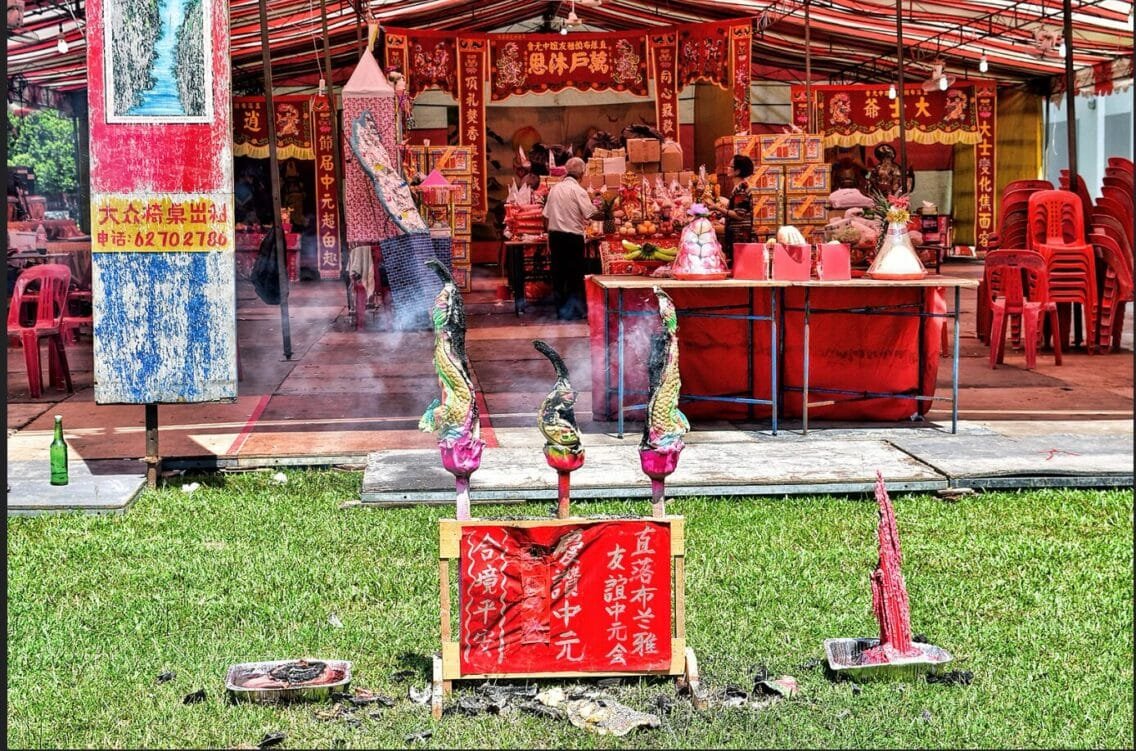Hungry Ghost Month Festival: Feeding Spirits in Singapore’s Neighbourhoods

In Singapore, the Hungry Ghost Festival (also known as the Seventh Month or Ghost Month Festival) is celebrated widely, particularly by the Chinese community. This traditional event, rooted in Chinese culture and Taoist beliefs, occurs during the seventh month of the lunar calendar. During this time, it is believed that the gates of the underworld open, allowing spirits—both benevolent and malevolent—to roam the Earth. Residents of Singapore, especially in Housing and Development Board (HDB) estates, can be seen offering food, burning incense, and performing rituals to appease these wandering spirits.
But while the history of the festival is fascinating, one of the most visually striking and culturally rich aspects is the type of food offered and the ritualistic purposes these foods serve.
A Brief History of the Ghost Month Festival
The origins of the Hungry Ghost Festival date back thousands of years and are linked to the Taoist and Buddhist traditions of ancestor worship. The seventh lunar month is traditionally regarded as a time when the spirits of the deceased are permitted to return to the living world. It is believed that during this period, those who passed away without a proper burial or who have unresolved affairs in the mortal world—often referred to as “hungry ghosts”—will wander the Earth.
In Singapore, the festival evolved as early immigrants brought their customs to the island, making it a vibrant, collective affair. Communities come together to ensure that these spirits, especially the “hungry” ones, are fed, appeased, and treated respectfully, thereby avoiding misfortune.
Types of Food Offered in Singapore’s Neighborhoods
One of the most distinctive sights during the Ghost Month in Singapore is the tables of offerings laid out in neighborhoods, especially outside HDB flats. The food varies but carries symbolic importance. Let’s explore some of the common offerings:
- Roast Meats (Pork, Duck, and Chicken): The rich, savory aroma of roasted meats such as sio bak (roast pork belly), roast duck, and chicken often fills the air. These are staple offerings, symbolizing respect and the desire to offer the best to the wandering spirits. Roast meats are tender, flavorful, and often seasoned with five-spice powder, providing an umami-rich experience for the living and symbolic “feast” for the dead.
- Fruits: Fruits such as oranges, bananas, apples, and pineapples are commonly placed on offering tables. These fruits not only represent health and prosperity but are also thought to refresh the spirits. Oranges, for example, are considered symbols of good fortune, and their sweet, tangy taste is believed to please both ancestors and wandering spirits.
- Rice and Noodles: Bowls of steamed white rice or plain noodles are often placed on the offering tables. These staple foods symbolize sustenance and the essence of life. Spirits are believed to feed on the spiritual essence of the food, so the simpler the dish, the more accessible and comforting it is for them.
- Pastries and Traditional Cakes: Delicacies such as ang ku kueh (red tortoise cake), nian gao (sticky rice cake), and mooncakes are frequently part of the offerings. The sweetness of these desserts is intended to please the spirits, and their chewy, soft textures evoke a comforting sensation. Each of these traditional cakes has symbolic meanings as well—ang ku kueh, for instance, is associated with good luck and longevity.
- Rice Wine or Tea: Beverages like rice wine or Chinese tea are also part of the offering. These drinks symbolize the spirits’ need for refreshment after a long journey from the underworld. The bitterness of tea balances the sweetness of fruits and pastries, representing life’s dualities.
- Candies and Biscuits: Sweet treats such as candies, biscuits, and wrapped chocolates are scattered around the offerings. These sweets, enjoyed by the living, are thought to bring joy to wandering souls, especially child spirits or playful entities.
The Taste and Symbolism Behind the Food
While these offerings may look like a delicious buffet to a passerby, the purpose of the food is entirely symbolic. The spirits don’t consume the physical food but rather the essence or energy of the offerings. The flavors, however, are chosen carefully to reflect a balance of tastes: savory, sweet, and refreshing. These different flavors reflect the harmony and balance that those making the offerings hope to achieve between the living and the dead.
The rich, umami taste of roasted meats contrasts with the light sweetness of fruits and pastries. The bitterness of tea or rice wine is a nod to the struggles and challenges faced by the spirits in the afterlife. Together, these flavors create a symbolic offering that shows deep respect, care, and a desire for peace between the mortal and spiritual worlds.
Who Are These Spirits?
The spirits believed to roam the Earth during Ghost Month are often categorized into two groups: ancestors and wandering spirits.
- Ancestors: These are the benevolent spirits of family members who have passed away. They return to visit their living descendants during this period. The food offerings, joss sticks, and rituals are meant to show respect, gratitude, and love for them. These spirits are generally seen as protectors and are highly revered.
- Wandering or Hungry Ghosts: These spirits are typically thought to be souls that did not receive a proper burial, died tragically, or were forgotten by their descendants. Unlike the ancestors, these spirits are restless, often seeking food, attention, and peace. They are sometimes considered malevolent or mischievous, capable of bringing bad luck or misfortune to the living if not properly appeased. Thus, the food and rituals are intended to prevent any form of spiritual unrest.
Good or Bad Spirits?
While the festival is based on the belief that both good and bad spirits roam freely, not all wandering spirits are evil. However, hungry ghosts—particularly those who are not honored or have unresolved grievances—can become troublesome if they are not appeased. Some may cause accidents, illness, or general misfortune. The festival’s rituals, such as burning joss paper, providing food, and offering prayers, aim to honor both benevolent ancestors and appease potentially dangerous spirits, ensuring peace for the living.
Conclusion: A Ritual of Respect and Balance
The Ghost Month Festival in Singapore is much more than an eerie celebration of spirits. It is a deeply rooted cultural tradition that highlights the balance between the living and the dead. The type of food placed around neighborhoods, outside homes, and HDB flats—ranging from savory roasted meats to sweet pastries—serves to bridge the gap between worlds. For many, it is a reminder that life and death are interconnected, and by honoring those who have passed, we ensure harmony and protection for ourselves and our loved ones.
Here are four references to learn more about the Ghost Month Festival and food offerings in Singapore:
- National Heritage Board – Provides an in-depth look at the cultural significance of the Hungry Ghost Festival in Singapore and its origins.
National Heritage Board – Ghost Month - The Straits Times – Features detailed accounts of the festival, including the food offerings and the beliefs surrounding spirits in Singapore.
The Straits Times – Hungry Ghost Festival - Mothership.sg – Highlights the significance of the festival in modern Singaporean society and discusses how people observe it today, including rituals and food.
Mothership.sg – Hungry Ghost Festival - China Highlights – Provides a broader overview of the festival’s traditions across Asia, including Singapore, focusing on customs, food offerings, and beliefs about spirits.
China Highlights – Hungry Ghost Festival
These references will give you a comprehensive understanding of the cultural and spiritual aspects of the festival, especially the significance of food offerings.



